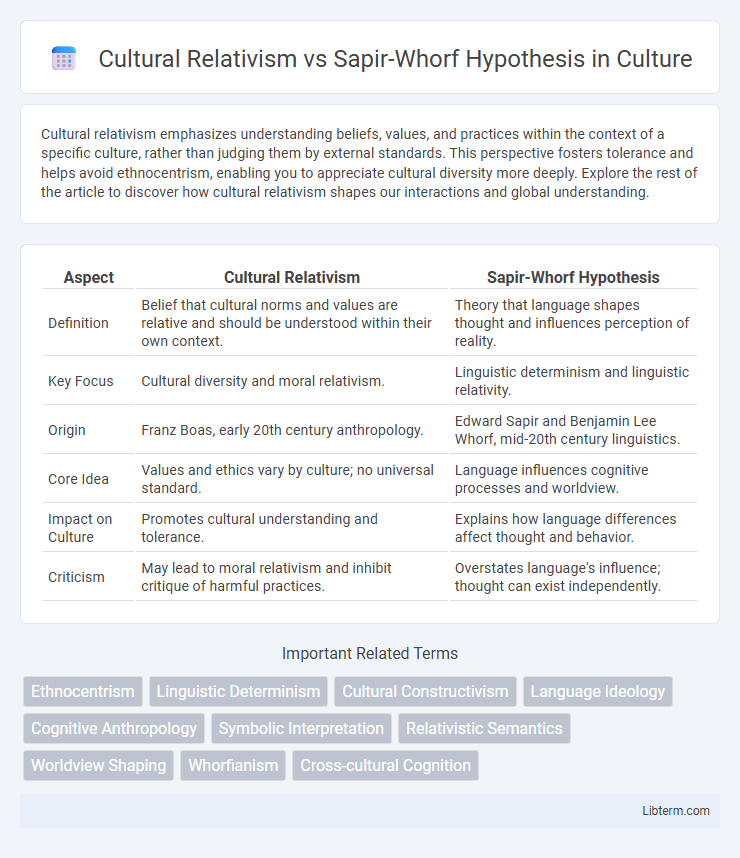Cultural relativism emphasizes understanding beliefs, values, and practices within the context of a specific culture, rather than judging them by external standards. This perspective fosters tolerance and helps avoid ethnocentrism, enabling you to appreciate cultural diversity more deeply. Explore the rest of the article to discover how cultural relativism shapes our interactions and global understanding.
Table of Comparison
| Aspect | Cultural Relativism | Sapir-Whorf Hypothesis |
|---|---|---|
| Definition | Belief that cultural norms and values are relative and should be understood within their own context. | Theory that language shapes thought and influences perception of reality. |
| Key Focus | Cultural diversity and moral relativism. | Linguistic determinism and linguistic relativity. |
| Origin | Franz Boas, early 20th century anthropology. | Edward Sapir and Benjamin Lee Whorf, mid-20th century linguistics. |
| Core Idea | Values and ethics vary by culture; no universal standard. | Language influences cognitive processes and worldview. |
| Impact on Culture | Promotes cultural understanding and tolerance. | Explains how language differences affect thought and behavior. |
| Criticism | May lead to moral relativism and inhibit critique of harmful practices. | Overstates language's influence; thought can exist independently. |
Introduction to Cultural Relativism and Sapir-Whorf Hypothesis
Cultural relativism posits that a person's beliefs and activities should be understood based on their own culture rather than judged against another, emphasizing cultural context in evaluating practices. The Sapir-Whorf Hypothesis, also known as linguistic relativity, suggests that the structure and vocabulary of a language influence its speakers' cognition and worldview. Both concepts highlight the significance of cultural and linguistic frameworks in shaping human perception and social behavior.
Defining Cultural Relativism: Key Concepts
Cultural relativism is the principle that an individual's beliefs and activities should be understood by others in terms of that individual's own culture, emphasizing the avoidance of ethnocentrism. It asserts that moral codes, social norms, and cultural practices are relative and cannot be judged outside their cultural contexts, promoting cultural sensitivity and respect. This concept contrasts with universalist approaches by focusing on cultural specificity and the diversity of value systems.
Exploring the Sapir-Whorf Hypothesis: Language and Thought
The Sapir-Whorf Hypothesis posits that the structure of a language significantly influences its speakers' cognition and worldview, suggesting that linguistic categories shape perceptual and conceptual experience. Unlike cultural relativism, which emphasizes understanding beliefs and practices within specific cultural contexts, the Sapir-Whorf Hypothesis centers on how language determines patterns of thought and behavior. Studies in linguistic anthropology demonstrate that language diversity correlates with variations in categorization, memory, and spatial reasoning, underscoring the hypothesis' impact on cognitive science.
Historical Background and Intellectual Origins
Cultural relativism emerged in the early 20th century through anthropologists like Franz Boas, emphasizing understanding cultures on their own terms rather than through ethnocentric lenses. The Sapir-Whorf Hypothesis, developed by Edward Sapir and Benjamin Lee Whorf in the 1920s and 1930s, explores how language influences thought and perception, rooted in linguistic anthropology. Both theories originated as critiques of universalist perspectives, challenging fixed notions of culture and cognition by highlighting the diversity in human experience shaped by cultural and linguistic contexts.
Major Proponents and Foundational Studies
Cultural Relativism, championed by anthropologists Franz Boas and Ruth Benedict, emphasizes understanding cultures on their own terms and was foundational in Boas's early 20th-century ethnographic studies. The Sapir-Whorf Hypothesis, developed by linguists Edward Sapir and Benjamin Lee Whorf, argues that language shapes thought and perception, supported by Whorf's analysis of Native American languages in the 1930s. Foundational studies for Cultural Relativism include Boas's work with the Kwakiutl, while Whorf's investigations into Hopi language structure provide critical evidence for linguistic relativity.
Language, Culture, and Perception: Areas of Overlap
Cultural relativism emphasizes that language shapes cultural practices and worldview, while the Sapir-Whorf hypothesis argues that language influences perception and cognitive patterns. Both concepts intersect in exploring how linguistic structures reflect and reinforce cultural norms, affecting individuals' interpretation of reality. The overlap highlights the dynamic interplay between language, culture, and perception in shaping human experience and social behavior.
Fundamental Differences Between the Two Theories
Cultural relativism emphasizes understanding beliefs and practices within their own cultural context without judgment, highlighting cultural diversity and ethical pluralism. In contrast, the Sapir-Whorf Hypothesis posits that language fundamentally shapes thought and perception, suggesting linguistic structures influence cognitive processes. The fundamental difference lies in cultural relativism's focus on external cultural interpretation, whereas the Sapir-Whorf Hypothesis centers on the internal relationship between language and cognition.
Criticisms and Contemporary Debates
Cultural relativism faces criticism for potentially promoting moral relativism, where harmful practices may be justified under cultural norms, challenging universal human rights frameworks. The Sapir-Whorf hypothesis is debated for its strong version--linguistic determinism--criticized for overstating language's influence on thought, while its weaker version, linguistic relativity, still prompts discussion on how language shapes perception and cognition. Contemporary debates explore the balance between acknowledging cultural diversity and ensuring ethical universality, alongside ongoing research in cognitive science assessing language's role in shaping worldview.
Real-World Applications and Implications
Cultural relativism promotes understanding and respecting diverse cultural practices without imposing external judgments, enhancing cross-cultural communication and reducing ethnocentric biases in global diplomacy and international business. The Sapir-Whorf Hypothesis, asserting that language shapes thought, informs approaches in linguistics and cognitive science, influencing bilingual education and artificial intelligence development by emphasizing language's role in perception and cognition. Together, these theories impact multicultural policy-making and communication strategies, facilitating more effective intercultural interactions and promoting inclusivity in globalized societies.
Conclusion: The Ongoing Relevance in Anthropology and Linguistics
Cultural relativism and the Sapir-Whorf hypothesis remain pivotal frameworks in anthropology and linguistics for understanding how language and culture shape human experience. Cultural relativism emphasizes the contextual nature of cultural practices without ethnocentric bias, while the Sapir-Whorf hypothesis explores the influence of language on thought and perception. Their ongoing relevance lies in fostering deeper cross-cultural empathy and advancing research on cognitive linguistics and cultural diversity.
Cultural Relativism Infographic

 libterm.com
libterm.com